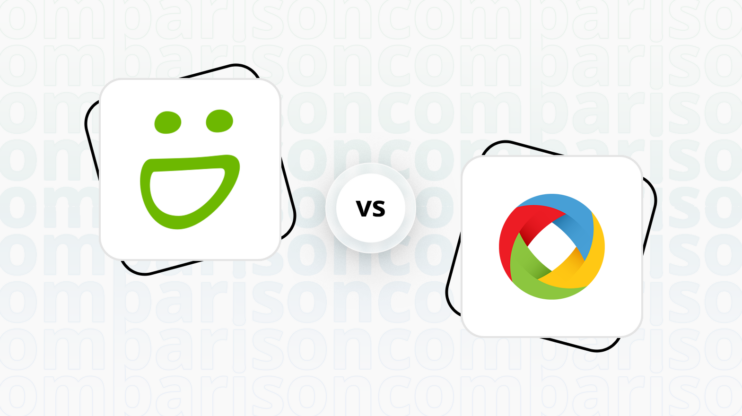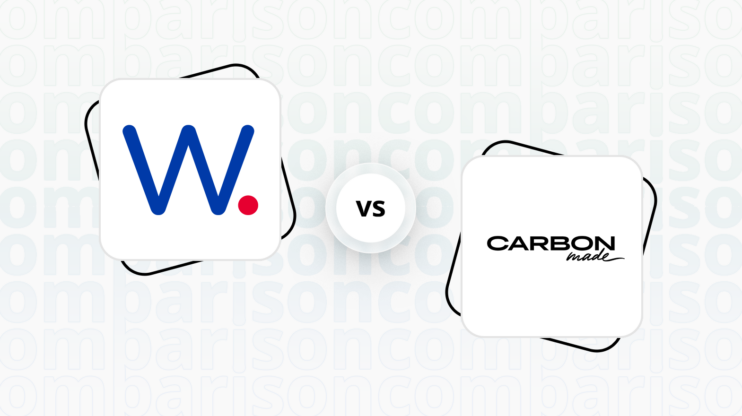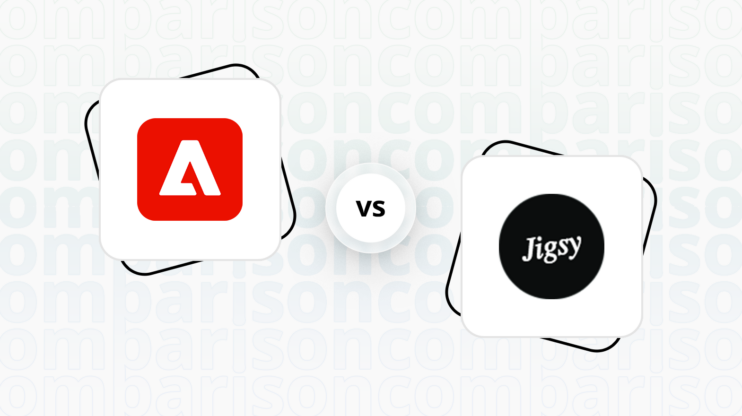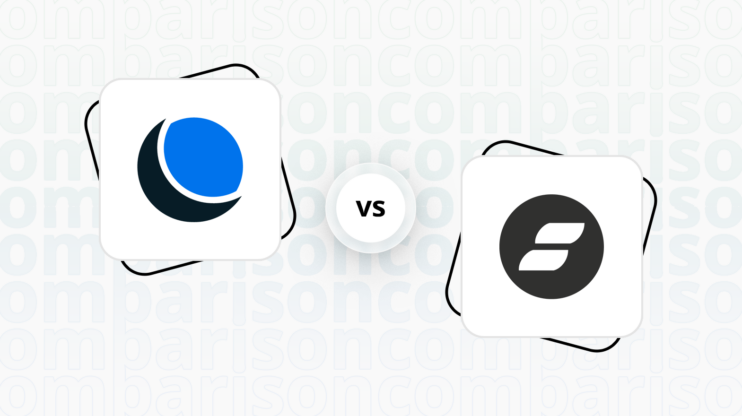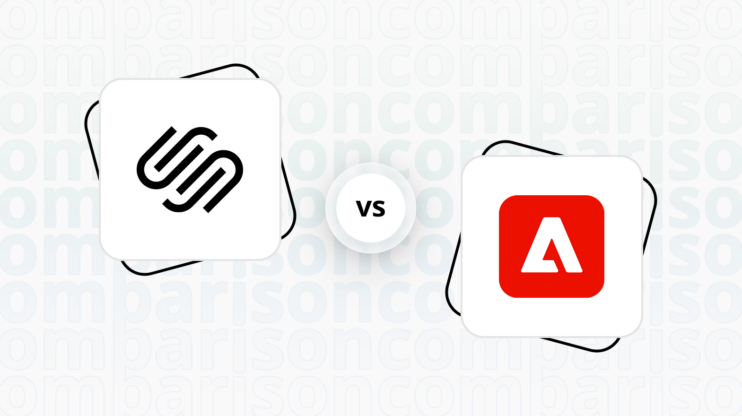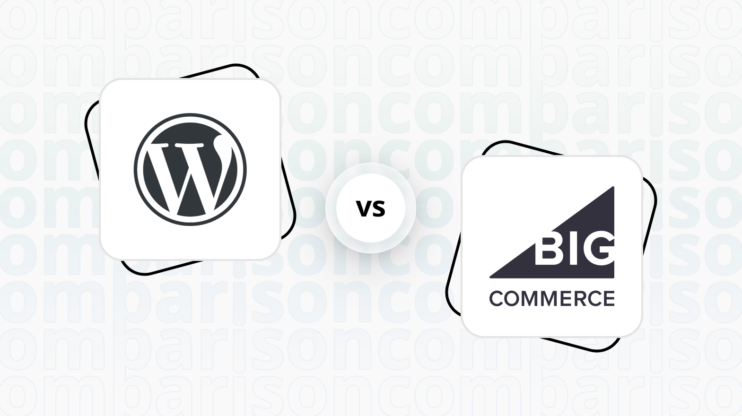Final verdict
Voog and Unbounce both offer unique strengths, catering to different user needs and preferences.
-
Voog (Overall Grade: 6.7/10)
is a versatile website builder ideal for creating multilingual websites with ease. It excels in providing a user-friendly interface, customizable templates, and essential ecommerce features. Voog is particularly well-suited for individuals and small businesses looking to establish a global online presence without extensive technical knowledge. Its strong focus on simplicity and design makes it a reliable choice for users prioritizing ease of use and multilingual support. -
Unbounce (Overall Grade: 6.4/10)
specializes in creating high-converting landing pages, popups, and sticky bars. It is favored for its robust conversion optimization tools, including A/B testing and Smart Traffic insights. Unbounce is perfect for marketers and businesses focused on lead generation and campaign performance. Its wide range of templates and integrations with marketing tools make it a powerful platform for optimizing conversion rates and enhancing digital marketing efforts.

|

|
|
|---|---|---|
|
Design functionalities & templates |
7.4 |
7.8 |
|
Ease of use |
8.1 |
8.2 |
|
Ecommerce |
6.9 |
4.8 |
|
Website editors |
7.6 |
7.5 |
|
Product testing options |
8.6 |
6.6 |
|
Price |
7.5 |
7.0 |
|
Hosting quality |
7.7 |
3.9 |
|
Website speed optimization |
6.2 |
5.6 |
|
Plugins/extensions and integrations |
6.7 |
6.8 |
|
Marketing features |
6.9 |
7.4 |
|
Customer support |
6.1 |
7.7 |
|
Website security |
7.7 |
8.4 |
|
AI capabilities |
0 |
7.5 |
|
User management |
7.3 |
7.2 |
Best for ecommerce
 6.9
6.9
 4.8
4.8
Verdict
: Voog is better suited for small businesses and individuals looking to create multilingual online stores, while Unbounce excels in creating high-converting landing pages with ecommerce integrations.
-
Voog
: Voog offers essential ecommerce features, making it suitable for small businesses and individuals. It supports multilingual websites, various payment methods, and customizable templates. Voog’s ecommerce capabilities include order management, global shipping, and product variants, making it a versatile choice for international businesses. However, when comparing Voog vs Unbounce, Voog’s ecommerce features are more basic and may not cater to larger, more complex online stores. -
Unbounce
: Unbounce is designed for creating high-converting landing pages, popups, and sticky bars. It integrates with ecommerce platforms like Shopify and Ecwid, allowing users to create targeted ecommerce landing pages. Unbounce’s focus on conversion optimization, A/B testing, and Smart Traffic insights makes it a powerful tool for marketers. However, it lacks the comprehensive ecommerce features found in Voog, making it less suitable for full-fledged online stores.
Best for informational & business websites
 7.5
7.5
 5.9
5.9
Verdict
: Voog is the better choice for creating and managing informational business websites, thanks to its user-friendly interface, multilingual support, and higher overall score in this category.
-
Voog
: Voog scores 7.5 for informational business websites, making it a strong contender in this category. It offers a versatile website builder with an intuitive drag-and-drop interface, making it easy for both beginners and experienced users to create professional-looking websites. Voog’s standout feature is its multilingual support, which is ideal for international businesses. Additionally, it provides a range of customizable templates, SEO tools, and responsive design options to ensure websites look great on all devices. -
Unbounce
: Unbounce, with a score of 5.9, is primarily designed for creating high-converting landing pages, popups, and sticky bars. While it excels in optimizing conversion rates and offers a user-friendly drag-and-drop interface, it is less suited for comprehensive informational business websites. Unbounce integrates well with various marketing tools and analytics platforms, making it a powerful tool for marketers but not the best fit for those looking to build a full-fledged informational site.
Detailed comparison
Design functionalities & templates
Design FunctionalitiesRepresents how well each platform allows for creative design and customization of websites.Score Components:
- Template Variety (30%): Range and quality of design templates.
- Customization (30%): Flexibility and options for design alterations.
- User Interface (20%): Ease and intuitiveness of the design process.
- Responsiveness (10%): Adaptability to different devices and screen sizes.
- Innovation (10%): Unique design features and tools.
 7.4
7.4
 7.8
7.8
🏆
Winner: Unbounce.
Unbounce edges out Voog with a slightly higher score, offering a more comprehensive set of design functionalities and templates.
Voog offers a diverse range of design templates across various categories tailored for different website types such as business services, online stores, blogs, and more, catering to a wide audience. The platform highlights specific templates for creating visually appealing and functional webstores and blogs, emphasizing user-friendly design and mobile responsiveness.
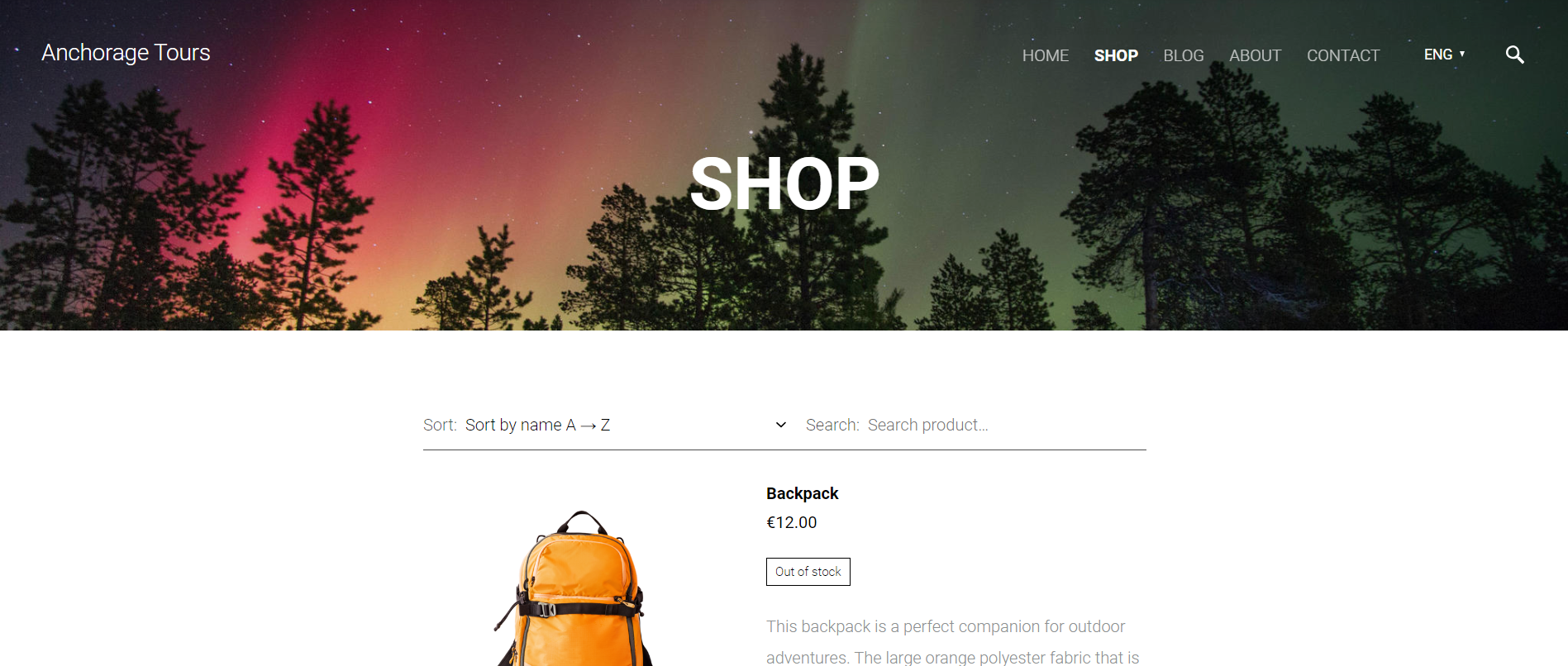
On the other hand, Unbounce provides a gallery of over 100 high-converting templates for landing pages, popups, and sticky bars. These templates are designed with conversion in mind, incorporating knowledge and insights gained from Unbounce’s experience in optimizing landing pages. Users have the flexibility to choose from these ready-to-use templates or start with a blank canvas to create their own designs using Unbounce’s drag-and-drop builder.
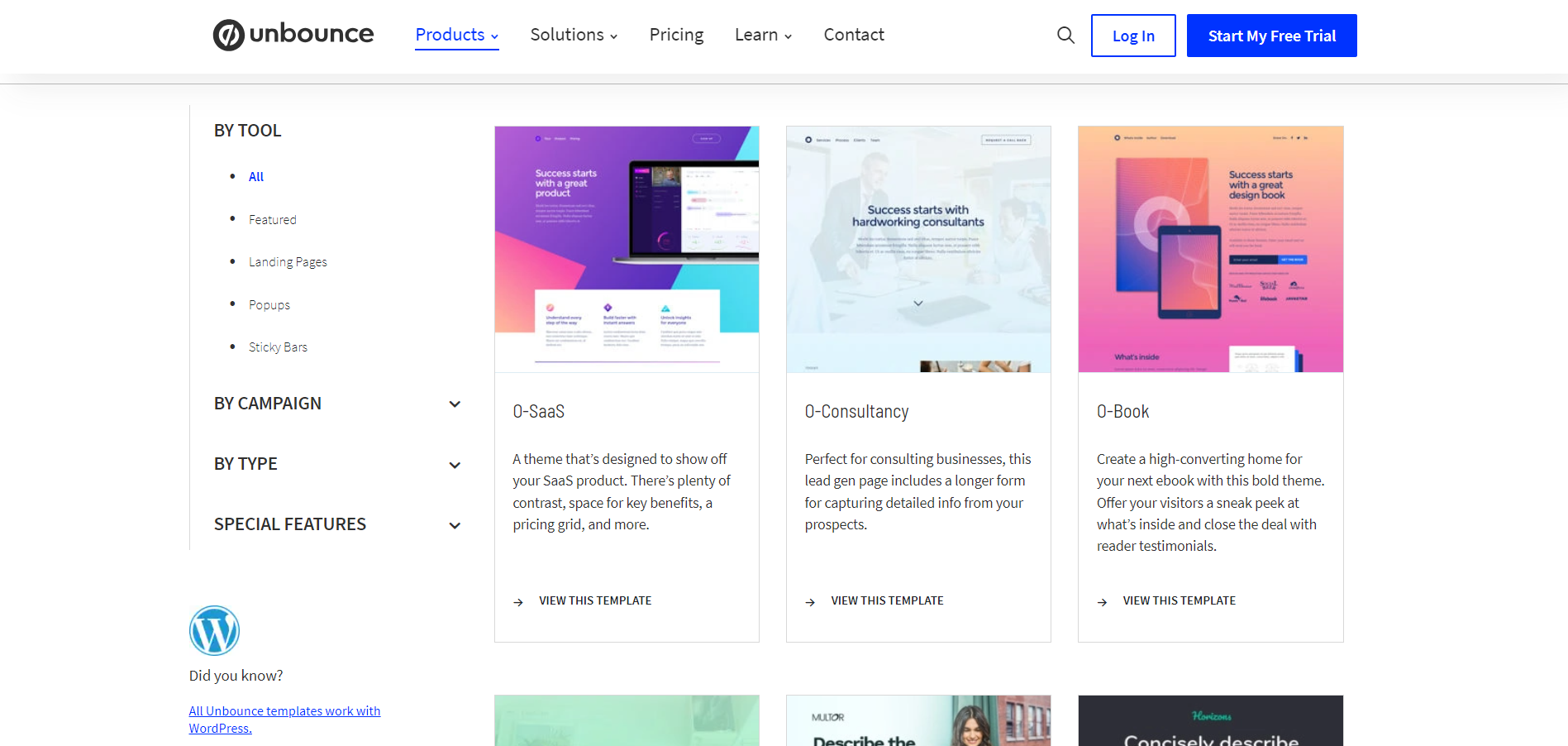
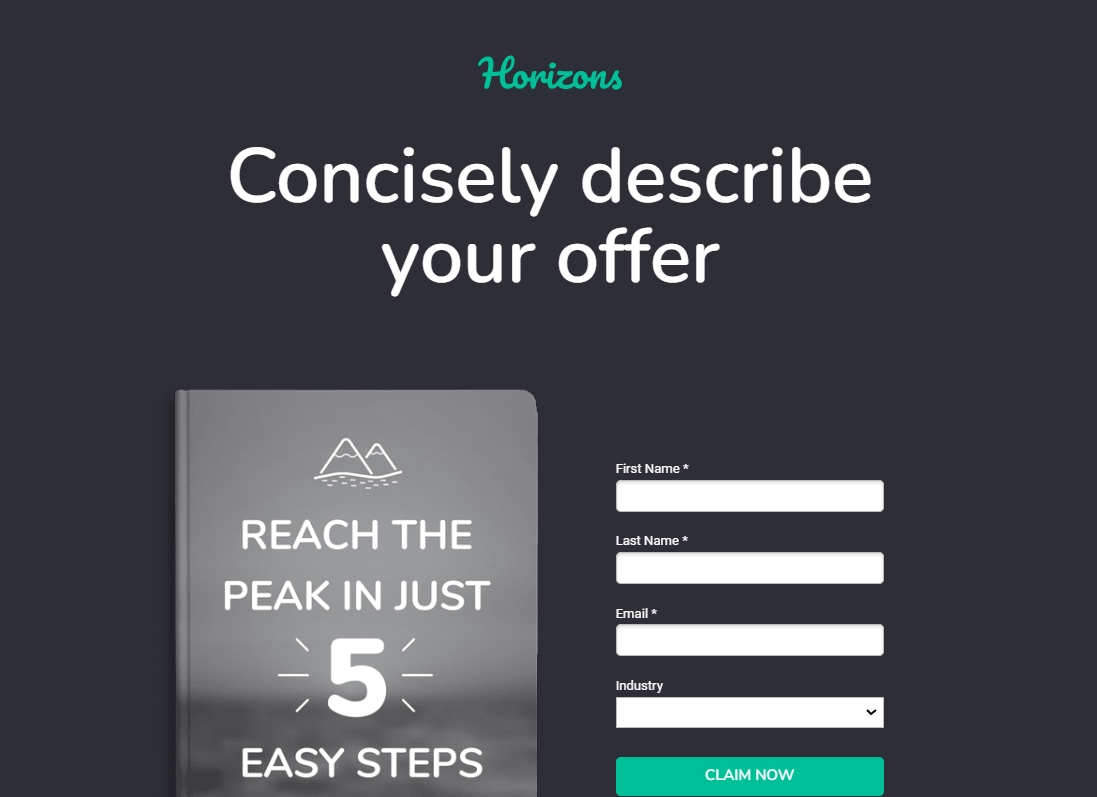
Get a head start on website creation with AI
Create a custom website tailored to your business needs 10X faster with 10Web AI Website Builder!
Ease of use
Ease of useReflects the platform’s overall user-friendliness.Score
Components:
- Learning curve (40%): Quickness and ease of getting started.
- Interface design (30%): Simplicity and intuitiveness of layout.
- User guidance (20%): Quality of tutorials and support.
- Flexibility (10%): Adaptability to various user skills.
 8.1
8.1
 8.2
8.2
🏆 Winner: Unbounce
. With a score of 8.2, Unbounce slightly edges out Voog, which scored 8.1. Unbounce is known for its intuitive drag-and-drop builder and a wide selection of templates, making it easy for users to design and customize landing pages. Voog, on the other hand, is praised for its simplicity and user-friendly interface, making it an excellent choice for individuals and small businesses looking to create and manage their websites without requiring extensive technical knowledge.
Learning Resources
🏆 Winner: Voog
. Both platforms offer solid learning resources, but Voog provides extensive learning resources tailored to a broad audience, from beginners to advanced users, ensuring an effective and enjoyable website-building experience. Its Help Centre offers detailed guides on various topics, including website creation, online store setup, blogging, and custom development, catering to diverse needs.
For ecommerce
EcommerceMeasures the platform’s effectiveness in supporting online business activities.Score Components:
- Ecommerce themes and templates (20%): Variety and design of templates.
- Product management (25%): Ease of managing and organizing products.
- Payment options (25%): Variety and convenience of payment methods.
- Ecommerce features (20%): Features for managing an ecommerce store.
- Integration (10%): Compatibility with external e-commerce tools and services.
 6.9
6.9
 4.8
4.8
Voog and Unbounce offer different approaches to ecommerce. Voog provides essential ecommerce features, making it suitable for individuals and small businesses looking to launch online stores with ease. It supports multilingual websites, various payment methods, and customizable templates, alongside tools for order management and global shipping. Unbounce, on the other hand, stands out for its ability to create, test, and customize highly targeted e-commerce landing pages, aiming to double conversion rates compared to traditional online stores. It features a wide array of tools for conversion optimization, including A/B testing and Smart Traffic insights, alongside the unique Smart Copy features for enhanced copywriting.

|

|
|
|---|---|---|
|
Ecommerce themes and templates |
6.5 |
2.0 |
|
Product page customization |
6.8 |
3.0 |
|
Payment processing and commissions |
7.0 |
6.5 |
|
POS capabilities |
5.0 |
0.0 |
|
Payment gateways |
7.5 |
7.0 |
|
Product numbers |
5.5 |
0.0 |
|
Additional ecommerce features |
6.0 |
4.5 |
Voog ecommerce features:
- Order management
- Global shipping
- Product variants
- Payment gateways integration
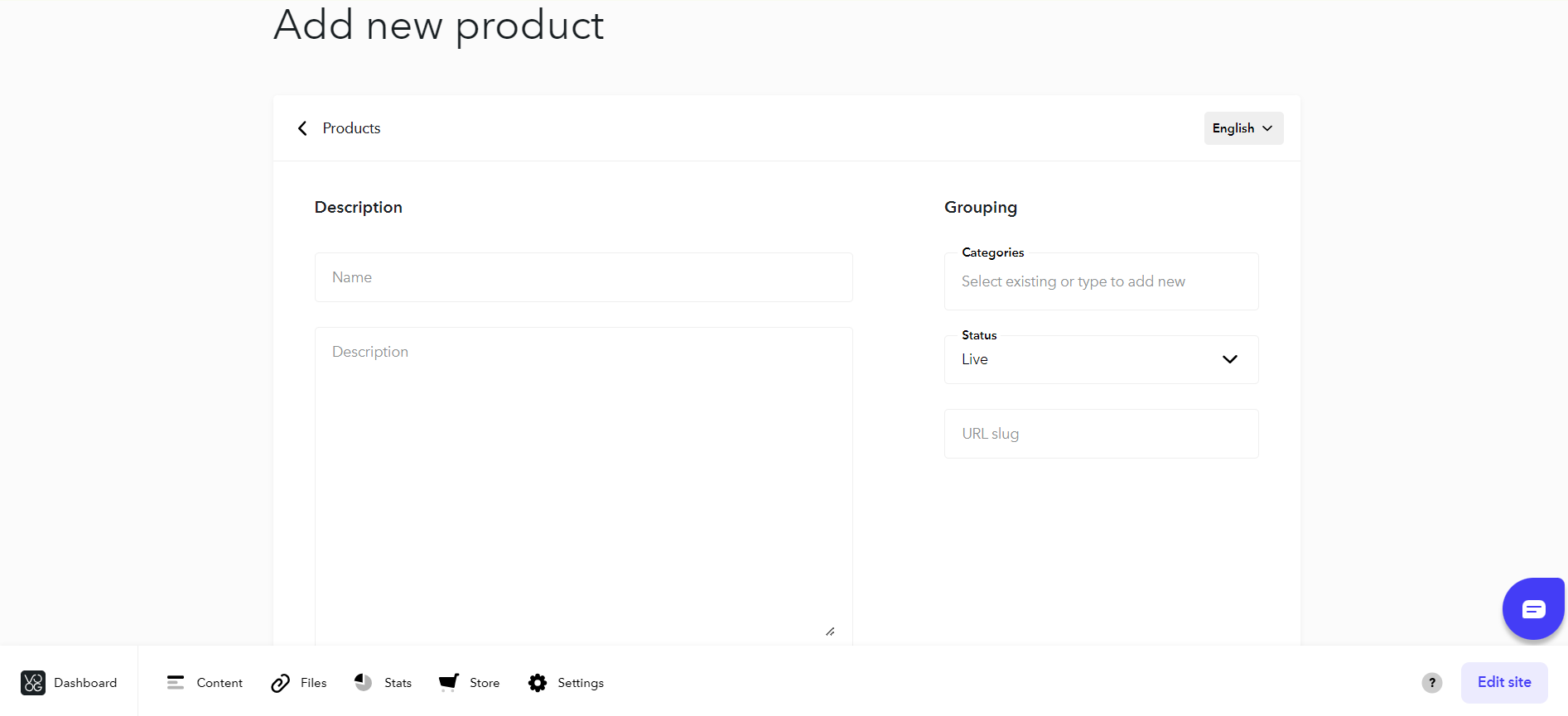
Unbounce ecommerce features:
- Shopify, Ecwid, or and other ecommerce solutions integration
Ecommerce themes & templates
For e-commerce, Voog highlights around 18 templates optimized for building online stores. These templates are praised for their attractive landing pages, spacious backgrounds for product images, and structured product and product list layouts, which aim to create a user-friendly browsing experience similar to visiting a physical store. Unbounce, on the other hand, primarily focuses on building landing pages, and does not have ecommerce specific templates.
Product page customization
Voog website builder provides functionality for customization of product pages within an online store. It enables the modification of various product aspects such as names, descriptions, categories, visibility status, and URL slugs. The system also allows for the inclusion of multiple images per product, and offers settings for net and sale prices, VAT rates, and inventory tracking. Voog facilitates the creation of product variants, like different colors or sizes, and allows for the adjustment of stock levels and variant visibility. Additionally, the platform includes features for optimizing product pages for search engines and social media, and permits the duplication of products to streamline the product setup process. Unbounce, on the other hand, does not have the possibility to create or customize product pages, it’s primarily focused on building landing pages, with the possibility to integrate with ecommerce platforms such as Shopify or Ecwid.
Payment processing
When it comes to payment processing, Voog supports a variety of payment gateways to accommodate diverse online transaction needs. Supported gateways include Swedbank Payment Gateway, Bank links through MakeCommerce (Nordics and Baltics), Montonio, Stripe, PayPal, EveryPay (for card payments and payment initiation), and Luminor Payment Gateway. These options offer flexibility in payment methods, catering to users in different regions and with different banking preferences. Voog also details its transaction fees, including a 3% fee for standard sales, while premium plan subscribers enjoy the benefit of no transaction fees. Unbounce supports payment processing through an integration with Stripe, allowing users to create landing pages that can handle transactions directly, with Stripe facilitating global payments in over 135 currencies. Unbounce itself does not mention charging additional fees for transactions, implying that fees are subject to Stripe’s own pricing structure. The platform is focused on optimizing online conversions and does not offer Point of Sale (POS) capabilities, as its core features are designed for enhancing digital experiences such as landing pages and pop-ups.
Website Editors
Website EditorsEvaluates the platforms’ website building and editing capabilities.Score Components:
- Customization tools (40%): Range and power of editing features.
- Editor usability (30%): User experience within the editor.
- Design flexibility (20%): Freedom in layout and design changes.
- Update and maintenance ease (10%): Simplicity of updating and maintaining the site.
 7.6
7.6
 7.5
7.5
🏆
Winner: Voog
. Voog, with a score of 7.6, offers a powerful and user-friendly website builder editor, catering to a wide range of needs from basic blogs to complex, multilingual websites. It offers a rich array of features including customizable templates, SEO tools, e-commerce functionalities, and developer-friendly tools for advanced customization. With its strong multilingual support, Voog stands out as an ideal choice for creating international websites, ensuring accessibility for a global audience.
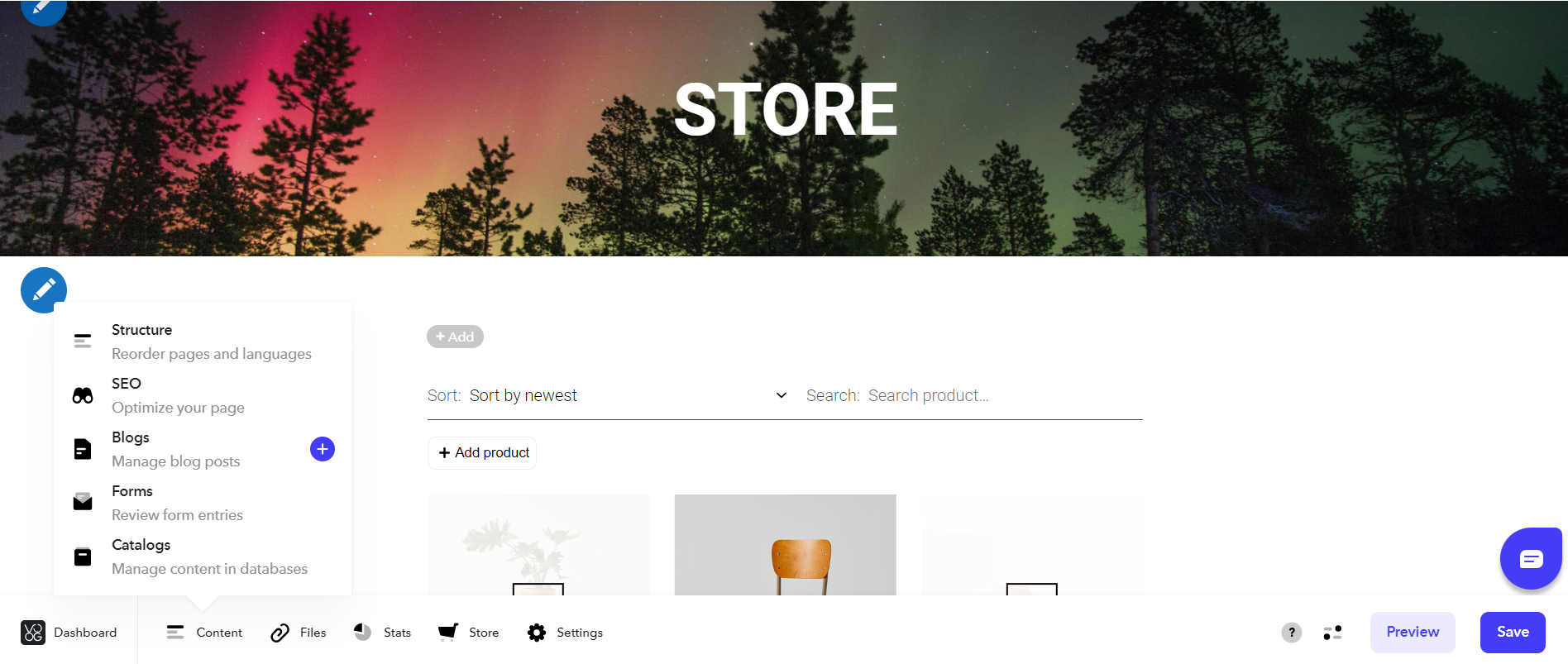
Unbounce’s website builder’s editor, scoring 7.5, is equipped with a user-friendly drag-and-drop interface, enabling users to design and customize landing pages without the need for coding skills. It offers a variety of templates, widgets, and elements such as forms and buttons, alongside options for integrating custom HTML, CSS, and JavaScript for advanced customization. The platform supports responsive design, ensuring landing pages perform well across all devices, and includes features for A/B testing and dynamic text replacement to optimize conversion rates.
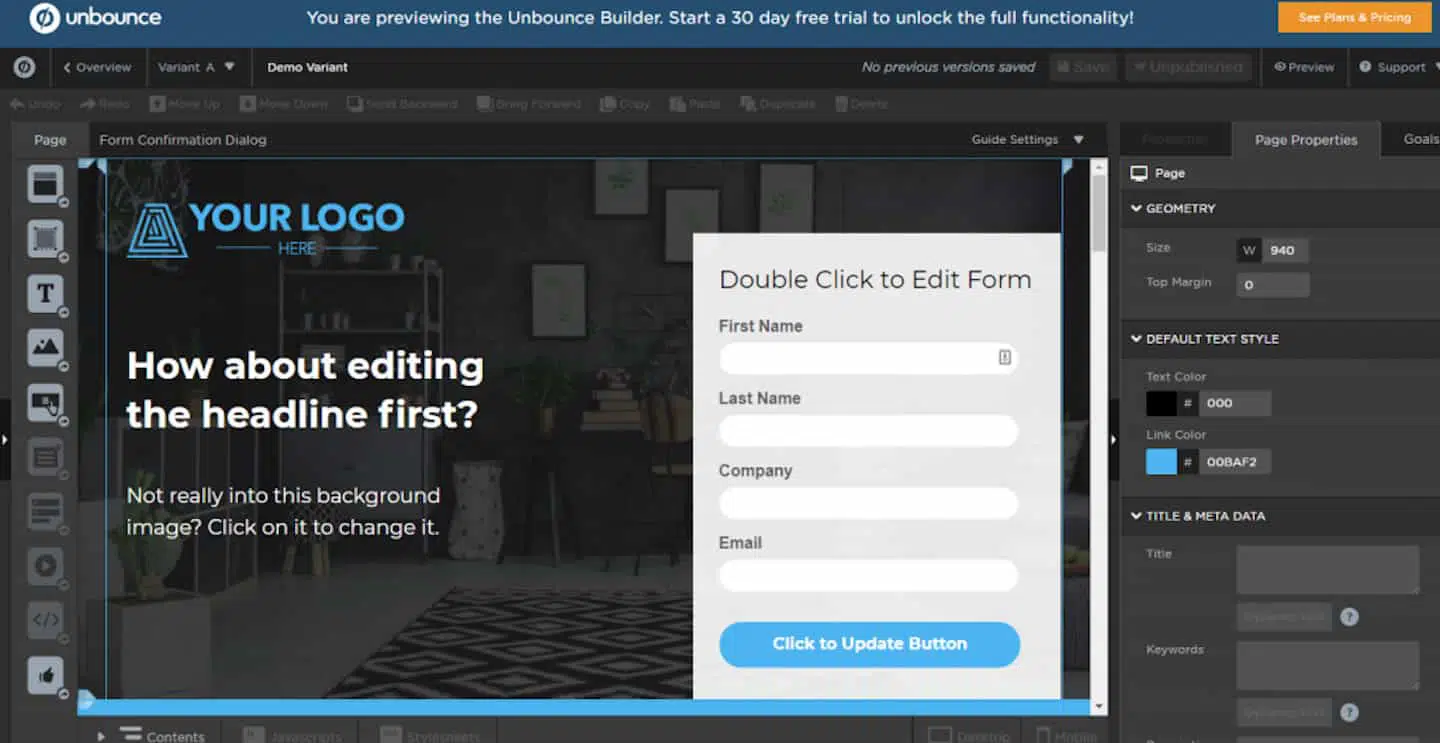
Mobile editor/app
 5.5
5.5
 0
0
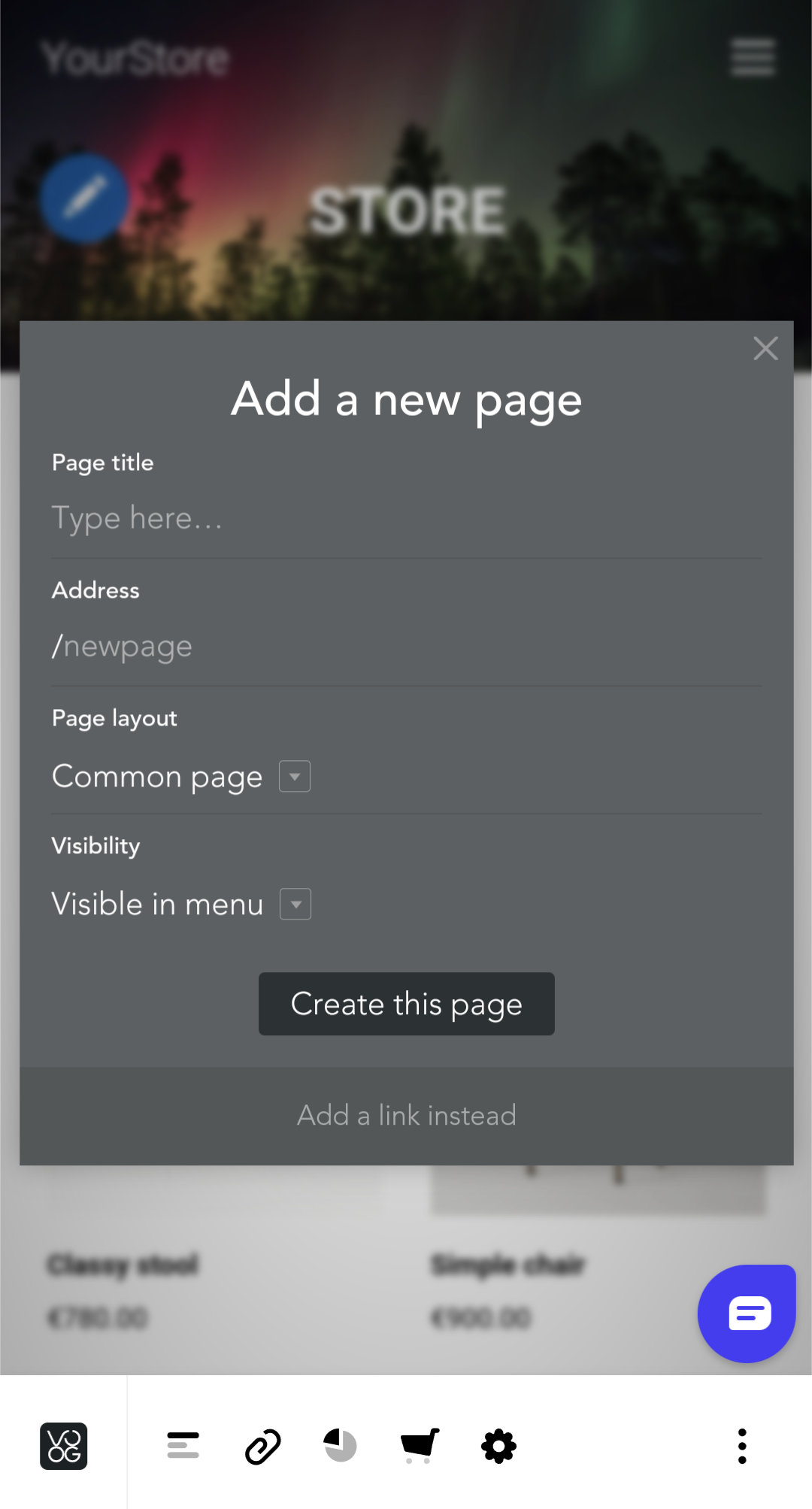
🏆
Winner: Voog
. Neither Voog nor Unbounce offer a dedicated mobile editor app. However, Voog allows users to manage and edit their websites using the mobile browser version of the editor, providing some level of convenience for on-the-go adjustments. Unbounce, on the other hand, does not offer this feature, limiting its flexibility for mobile editing.
Therefore, Voog scores higher in this category due to its mobile browser editing capabilities.
Product testing options
Product Testing OptionsAssesses the options for trying out platform features before commitment.Score Components:
- Trial quality (40%): Extent and usefulness of the trial or free version.
- Feature accessibility (30%): How many features are available to test.
- Trial duration (20%): Length of the trial period.
- Ease of transition (10%): Smoothness of moving from trial to paid plans.
 8.6
8.6
 6.6
6.6
Overall Result
:
Voog Wins
. Voog scores 8.6 in product testing options, while Unbounce scores 6.6. Voog offers a longer trial period of 30 days compared to Unbounce’s 14 days. Both platforms allow testing of premium features during the trial period, but Unbounce requires users to enter their billing information for the free trial.

|

|
|
|---|---|---|
|
Free Plan |
No | No |
|
Trial Duration |
30 days |
14 days |
|
Testing Premium Features |
Yes, during free trial |
Yes, during free trial (billing info required) |
|
Money Back Guarantee |
No | No |
Price
PriceLooks at the cost-effectiveness and value for money of each platform.Score Components:
- Plan value (40%): What each pricing tier offers.
- Transparency and clarity (30%): Clearness of pricing structures.
- Flexibility of plans (20%): Range of options to suit different budgets.
- Hidden costs (10%): Additional expenses not included in the plan.
 7.5
7.5
 7.0
7.0
Voog and Unbounce have similar pricing scores, but their offerings differ significantly. Voog is more suited for creating and managing multilingual websites, while Unbounce focuses on optimizing conversion rates with custom landing pages.

|

|
|
|---|---|---|
|
$10-$20 |
Standard (€14/month): Good for simple websites, with unlimited bandwidth, up to 30 website pages, online store with up to 3 products, 3% transaction fees, 5GB file storage, and up to 3 contributors. Value for price: 6.5 |
No offering at this amount. |
|
$20-$30 |
Plus (€22/month): Recommended for most users for more advanced websites, with free custom domain if annual subscription is purchased, unlimited bandwidth, unlimited website pages, online store with unlimited products, 3% transaction fees, 20GB file storage, and unlimited contributors. Value for price: 8.0 |
No offering at this amount. |
|
$50-$100 |
Premium (€50/month): Designed for more advanced needs with free custom domain if annual subscription is purchased, unlimited bandwidth, unlimited website pages, online store with unlimited products, no transaction fees, unlimited file storage, and contributors. Value for price: 9.0 |
Build ($99.00/month): Provides tools for building and launching high-converting landing pages, unlimited pages, popups, sticky bars, a form builder, free hosting, AI copywriting, custom scripts, 1,000+ integrations, support for 1 root domain with unlimited subdomains, catering up to 20,000 monthly unique visitors. Value for price: 6.5 |
|
$100-$200 |
No offering at this amount. |
Experiment ($149.00/month): Includes everything in the Build plan plus unlimited A/B tests, advanced reporting, dynamic text replacement, support for 2 root domains, and up to 30,000 monthly unique visitors. Value for price: 7.5 |
|
$200-$300 |
No offering at this amount. |
Optimize ($249.00/month): Adds to the Experiment plan with AI traffic optimization, visitor behavior insights, advanced targeting, supports 3 root domains, and caters to up to 50,000 monthly unique visitors. Value for price: 8.0 |
|
$600+ |
No offering at this amount. |
Concierge (Starting at $649/month): Offers everything in the Optimize plan plus dedicated support, implementation services, client and user management, flexible add-on plans for scaling, starting with 5 root domains and 100,000 monthly unique visitors, with options to scale. Value for price: 8.5 |
location. As a result in rare cases the prices displayed here can differ from the ones you see on their
websites.
Hosting quality
Hosting
qualityExamines the reliability and performance of the hosting solutions.Score Components:
- Uptime (40%): Consistency and reliability of website availability.
- Speed (30%): Loading times and performance.
- Bandwidth and storage (20%): Sufficiency of resources provided.
- Data centers (10%): Quality and distribution of hosting infrastructure.
 7.7
7.7
 3.9
3.9
Winner: Voog
. Voog offers hosting with unlimited bandwidth, storage options ranging from 5GB to unlimited, and automated daily backups. It also guarantees an uptime of 99.9%. Unbounce, on the other hand, does not specify the type of hosting it provides and does not offer an uptime guarantee, despite having a slightly higher uptime of 99.96%. Both Voog and Unbounce do not disclose the locations of their data centers.

|

|
|
|---|---|---|
|
Do they offer hosting? |
Yes | Yes |
|
Type of hosting: |
Not specified | Not specified |
|
Uptime: |
99.9% | 99.96% |
|
Uptime Guarantee: |
Yes, 99.9% | No |
|
Data Centers: |
Not disclosed | Not disclosed |
Website Speed Optimization
Website Speed OptimizationEvaluates optimization of website loading timesScore Components:
- PageSpeed Score (30%): Google’s score indicating performance optimization.
- Loading Time (30%): The average time until a website is fully interactive.
- Mobile Optimization (15%): Optimization effectiveness for mobile devices.
- Resource Optimization (15%): Optimizing images, scripts, and other heavy resources.
- CDN Usage (10%): Use of CDN to enhance speed across geolocations.
 6.2
6.2
 5.6
5.6
🏆 Winner: Voog
Both Voog and Unbounce have strategies in place for website speed optimization, but Voog edges out Unbounce with a slightly higher score.

|

|
|
|---|---|---|
|
Key Strategies |
Mobile Responsive design, Caching, Image Optimization, Code minification |
Image optimization, Caching, Speed Booster |
|
Load Times |
Varies depending on optimization and website complexity |
Varies depending on optimization and website complexity |
|
Page Speed Scores Range |
Varies depending on optimization and website complexity |
Varies depending on optimization and website complexity |
|
Core Web Vitals Improvement |
No information disclosed |
No information disclosed |
Voog, a versatile website builder, focuses on mobile responsive design, caching, image optimization, and code minification for speed optimization. However, the load times and PageSpeed scores vary depending on the optimization and complexity of the website. Voog does not disclose any information on their Core Web Vitals improvements.
Unbounce, a website builder designed for creating custom landing pages, also prioritizes image optimization and caching for speed optimization. They also have a feature called Speed Booster. Similar to Voog, the load times and PageSpeed scores of Unbounce vary depending on the optimization and complexity of the website. Unbounce does not provide any information on their Core Web Vitals improvements.
Get a head start on website creation with AI
Create a custom website tailored to your business needs 10X faster with 10Web AI Website Builder!
Plugins and integrations
Plugins and integrationsMeasures the range and effectiveness of additional plugins and integrations.Score Components:
- Variety of options (40%): Range of available add-ons.
- Integration smoothness (30%): Ease of integrating plugins into the site.
- Quality of plugins (20%): Functionality and reliability of the options.
- Custom integration capabilities (10%): Support for custom or third-party integrations.
 6.7
6.7
 6.8
6.8
🏆 Winner: Unbounce.
With a score of 6.8, Unbounce slightly edges out Voog, which scores 6.7. Unbounce offers over 50 free apps and integrations, enhancing the functionality of landing pages. It allows for advanced analytics, enhanced marketing automation, direct e-commerce transactions, and personalized user engagements.
Voog, on the other hand, offers a wide range of integrations categorized into areas such as Finance, Social Media, Utilities, and Shipping. These integrations significantly enhance its base functionality, enabling features not originally possible with the platform alone. However, the pricing of integrations varies depending on the provider, which might be a consideration for some users.
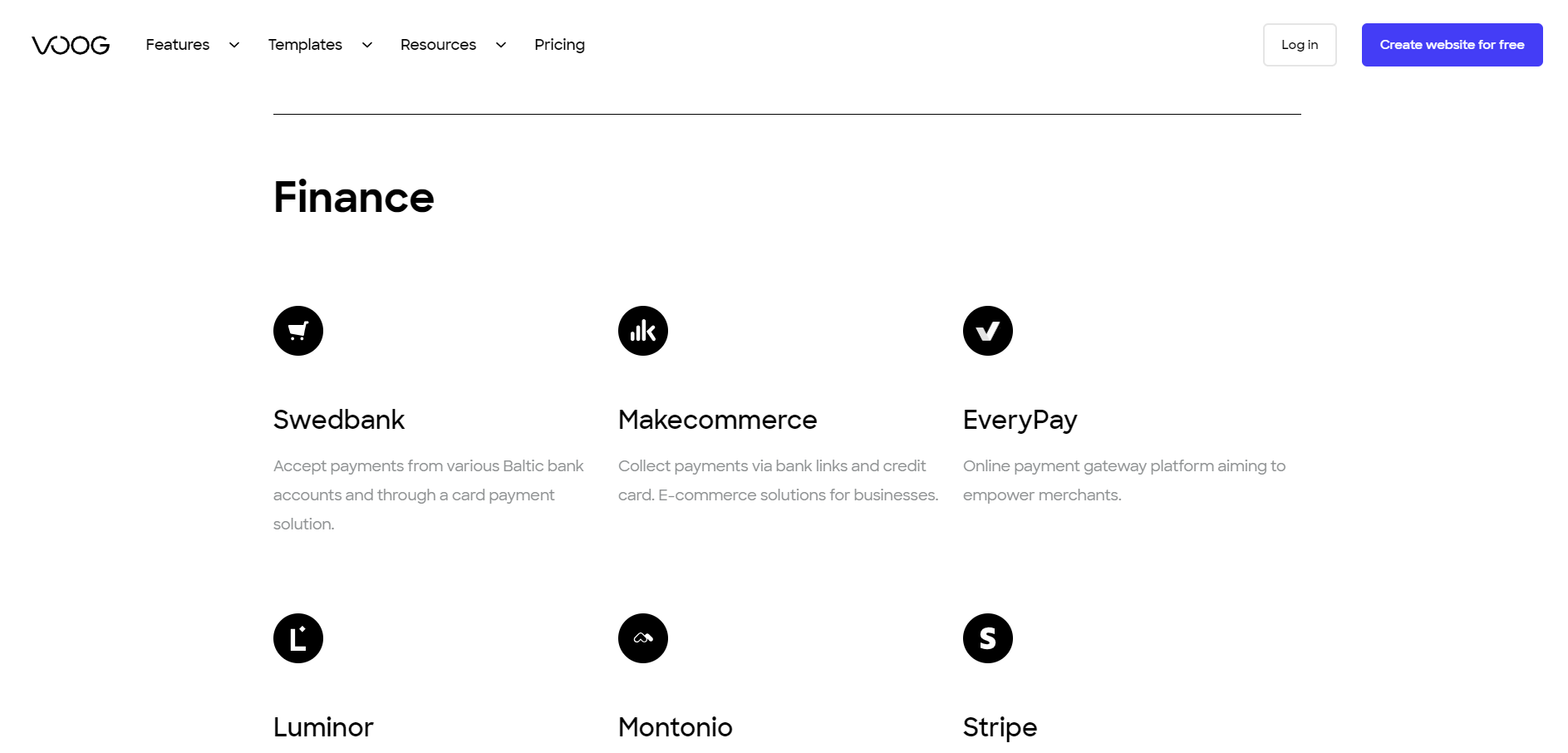

Marketing Features
Design FunctionalitiesRepresents how well each platform allows for creative design and customization of websites.Score Components:
- Template Variety (30%): Range and quality of design templates.
- Customization (30%): Flexibility and options for design alterations.
- User Interface (20%): Ease and intuitiveness of the design process.
- Responsiveness (10%): Adaptability to different devices and screen sizes.
- Innovation (10%): Unique design features and tools.
 6.9
6.9
 7.4
7.4
🏆
Overall Winner: Unbounce
. Unbounce stands out for its strong focus on conversion optimization, making it a powerful tool for ad campaigns and promotions. Voog, while offering a range of marketing features, lacks the specialized focus on conversion optimization that Unbounce provides.

|

|
|
|---|---|---|
|
SEO Tools |
|
|
|
Email Marketing |
✓ (through third-party integrations) |
✓ (through third-party integrations) |
|
Blogging |
|
|
|
Social Media Integration |
|
|
|
Analytics and Reporting |
Basic built-in analytics tools, Google Analytics integration |
Comprehensive insights into user interactions |
|
Ads and Promotions |
Yes, through integration of third-party services |
Specialized solutions for enhancing campaigns |
Customer Support
Customer supportEvaluates the quality and availability of support options.Score Components:
- Response time (40%): Speed of support responses.
- Support quality (30%): Effectiveness and helpfulness of the support.
- Availability (20%): Range of support channels (phone, chat, email).
- Resource richness (10%): Quality of self-help and educational materials.
 6.1
6.1
 7.7
7.7
🏆 Winner: Unbounce
. In the Voog vs Unbounce comparison, Unbounce takes the lead with its comprehensive customer support options. Unbounce offers live chat, email, and phone support, with live chat and phone support available Monday to Friday, from 6 AM to 6 PM PST. Additionally, users can access 24/7 support through their Help Centre, Community, and Chat Bot, ensuring continuous assistance.
Voog, on the other hand, provides customer support through email, available 7 days a week. While Voog offers a range of support guides to help users, it lacks the extensive support channels and availability that Unbounce provides. This makes Unbounce a more robust option for users seeking reliable and accessible customer support.
Security
SecurityLooks at the platforms’ security measures and data protection.Score Components:
- Data protection (40%): Safeguards for user and customer data.
- SSL and encryption (30%): Implementation of secure connections.
- Compliance (20%): Adherence to industry security standards.
- Regular updates (10%): Frequency of security updates and patches.
 7.7
7.7
 8.4
8.4
🏆
Winner: Unbounce
. Unbounce takes the lead in security with a score of 8.4, compared to Voog’s 7.7. Unbounce’s security measures are comprehensive, including PCI Level 4 Merchant status, GDPR adherence, robust disaster recovery strategies, and regular external security audits. The platform also employs a secure, multi-tenant environment with strict access controls and daily data backups to safeguard customer information.
Voog, on the other hand, also prioritizes user data protection and website security. It provides SSL encryption and manages technical aspects such as hosting, security updates, and backups on behalf of the user. However, Unbounce’s more robust security framework and higher security score give it the edge in this comparison.
AI Capabilities
AI capabilitiesMeasures the effectiveness of AI-driven features and tools.Score Components:
- Automation efficiency (40%): Impact of AI on streamlining processes.
- Personalization (30%): AI-driven customization for users or customers.
- AI-Assisted design (20%): Role of AI in website design and functionality.
- Data analysis (10%): Use of AI in interpreting user data and analytics.
 0
0
 7.5
7.5

|

|
|
|---|---|---|
|
Personalized Design |
|
Unbounce’s Smart Builder offers personalized templates and design recommendations |
|
Content Generation |
|
Unbounce’s Smart Copy helps in generating various types of content |
|
Visitor Direction |
|
Unbounce’s Smart Traffic directs visitors to the most appropriate landing page variant |
|
Conversion Rate Optimization |
|
Unbounce’s Conversion Intelligence Insights provides practical advice and recommendations to boost overall conversion rates |
🏆 Winner: Unbounce
. Unbounce, with a score of 7.5, utilizes AI to optimize landing page creation, content generation, visitor direction, and conversion rate optimization. Its AI features are user-friendly and innovative, making it easy for users to create high-converting pages without needing any coding skills.
Voog, on the other hand, does not have any AI capabilities. It focuses more on simplicity and design, offering users an intuitive drag-and-drop interface and multilingual support. However, it lacks the AI features that Unbounce provides, making Unbounce the clear winner in terms of AI capabilities.
User Management
User ManagementAssesses the platforms’ capabilities in managing user roles, permissions, and accessibility.Score Components:
- Role Customization (40%): Flexibility in creating and defining user roles and
permissions. - Ease of Management (30%): User interface and tools for managing users.
- Access Control (20%): Effectiveness of access control measures for different user
levels. - Scalability (10%): Ability to manage a growing number of users efficiently.
 7.3
7.3
 7.2
7.2
🏆 Winner: Voog
. Both Voog and Unbounce offer different levels of user management capabilities.
- Voog allows up to 3 contributors on the Standard plan, with no limit on the Plus or Premium plans. This flexibility caters to both small teams and larger organizations.
- Unbounce offers one staff account on its basic plan, with the option to expand up to 15 accounts on the premium plan. It also provides customizable permissions based on roles.
Voog User Roles and Access Levels:
| Role | Description | Access Highlights |
|---|---|---|
| Admin | Admins, also known as owners, have full control over the website. They can manage all aspects of the site without any restrictions. | Full site management, including key account settings like subscription info. |
| Editor | Editors can manage certain aspects of the site, but they do not have access to key account settings. Their role is more focused on content management. | Limited to certain site settings; cannot manage subscription or account settings. |
Unbounce User Roles and Access Levels:
| Role | Description | Access Highlights |
|---|---|---|
| Viewers | Members of your team who want to view and approve pages, popups, or sticky bars before publication. | Can access pages, popups, sticky bars, stats, and leads. Cannot edit/manage pages or access account management, billing details, domains, or add users. |
| Authors | Designers or copywriters invited to edit landing pages. | Can edit, manage, publish/unpublish pages, popups, sticky bars. Have access to viewing leads and stats. Cannot access account management, billing details, domains, or add users. |
| Administrators | Manage the Unbounce account, including billing details. | Can edit, manage, publish/unpublish pages, popups, sticky bars. Can access account management, billing details, domains, and add users. Cannot delete leads or remove other Admins. |
Additional Features

|

|
|
|---|---|---|
|
SSL Certificate |
|
|
|
Custom Domain |
|
|
|
Free Custom Domain Included |
|
|
|
International Domains |
|
|
|
Mobile Responsive |
|
|
|
Page Speed |
|
|
|
Website Builder Mobile App |
|
|
|
Convert a Website To An App |
|
|
|
Website Analytics |
|
|
|
Multilingual Sites |
|
|
|
Multiple Users |
|
|
User Feedback
Voog receives high praise for its ease of use, allowing users to create their workspace seamlessly. Users appreciate its problem-solving capabilities, particularly in facilitating better client navigation. However, some feedback indicates a desire for a more diverse and larger selection of stock photos. Overall, Voog’s strong focus on simplicity and design, coupled with its multilingual support, makes it a favored choice for international businesses and personal sites.
Unbounce, on the other hand, garners mixed reviews. Users commend its user-friendly drag-and-drop page builder, which is excellent for creating and editing landing pages quickly without technical expertise. It is also valued for its A/B testing capabilities and integration with various marketing tools. However, some users have reported issues with customer service and billing practices, as well as technical limitations like responsiveness issues and the absence of global elements for content updates across multiple pages. These concerns may affect user satisfaction when comparing Voog vs Unbounce.
The making of this blog
We followed a clear, step-by-step process to write and research this article.
FAQ
Which platform is better for creating multilingual websites, Voog or Unbounce?
Can I use Voog and Unbounce for ecommerce?
How do Voog and Unbounce compare in terms of design and templates?
Which platform is easier to use, Voog or Unbounce?
Are Voog and Unbounce suitable for beginners?
Which platform offers better customer support, Voog or Unbounce?
How do Voog and Unbounce handle website security?
Can I test Voog and Unbounce before committing to a plan?
Which platform is better for marketing and conversion optimization?
Do Voog and Unbounce offer AI capabilities?










